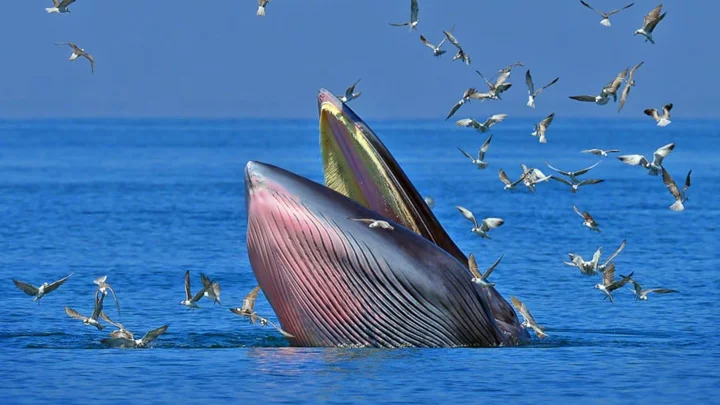Despite their size, whales are remarkably graceful and can make even the most mundane action look like a beautifully choreographed water show. In a clip filmed by researchers at Auckland University of Technology (AUT) in New Zealand, an approximately 39-foot-long adult Bryde’s whale and a young calf are shown feasting on plankton off the coast of the islands. The footage was captured using a drone custom built by AUT scientists.
The footage shows the whales swimming near the surface of the water before turning on to their sides to open their mouths to feed. The cetaceans’ accordion-like throats can be seen expanding as they take in hundreds of gallons of water. According to the National Oceanic and Atmospheric Administration, the Bryde’s whales’ diet includes proteins like krill, shrimp, copepods, and pelagic crabs, as well as schools of herring, mackerel, and sardines.
Bryde’s (pronounced BROO-duhs) whales are named after the Norwegian whaler Johan Bryde, who established whaling stations in South Africa in the early 20th century. Though industrial whaling decimated populations of the world’s largest cetaceans, including blue, sei, humpback, and fin whales, they and Bryde’s whales are now protected by international agreements and the U.S. Marine Mammal Protection Act, which makes it illegal to “hunt, harass, capture, or kill any marine mammal” or even attempt these actions.
Bryde’s whales are among the rarest cetacean species. They have a vast range across the world’s tropical, subtropical, and temperate oceans, but they are threatened by underwater energy exploration, ocean noise, vessel strikes, and pollution. According to AUT, they’re “critically threatened” in New Zealand, with fewer than 200 believed in the region.
Scientists recently discovered that a subspecies of Bryde’s whale that lives exclusively in the Gulf of Mexico is actually its own species, now named Rice’s whale (Balaenoptera ricei). It, too, is critically endangered, with perhaps as few as 50 in existence.
This is far from the first time drones have helped scientists learn more about whales—they’ve even helped collect their snot.
A version of this article was originally published in 2016 and has been updated for 2023.
This article was originally published on www.mentalfloss.com as Watch Rare Drone Footage of Bryde’s Whales Feeding.









